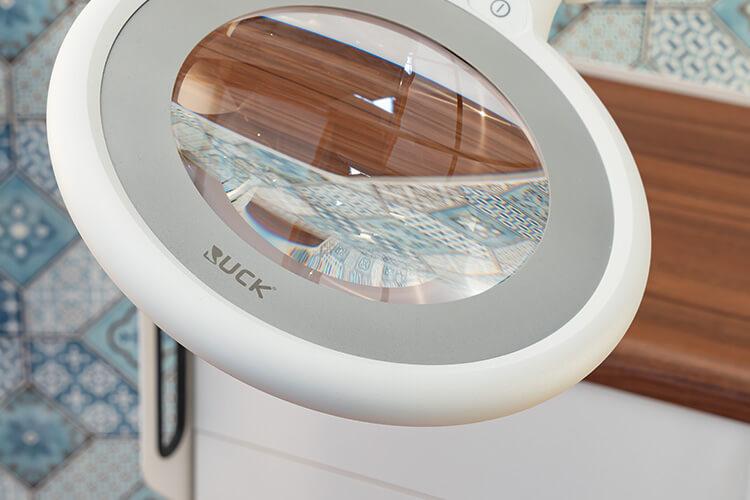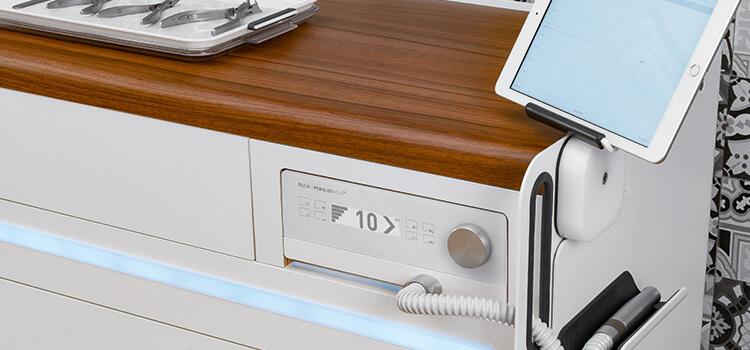How to work ergonomically in your podiatry practice
Ergonomics - more than just a word
In your daily professional life, you are dedicated to ensuring that your patients live with healthy feet. But for you to be able to continue this, it is imperative that you adapt your workplace to your physical needs. Without consideration of your personal well-being, the treatments, which last on average 45 minutes, cannot be carried out without causing long-term health problems. Fortunately, there is the subject of ergonomics: it is the science of optimal adaptation between people and technology in view of their working conditions.
Making adjustments is not as difficult as it seems. No matter what your treatment room and budget look like, there are plenty of ergonomic solutions. In order to improve the conditions in your everyday professional life and to use your practice equipment in a way which is friendly to your back, we have compiled the most important factors and valuable tips for you below.
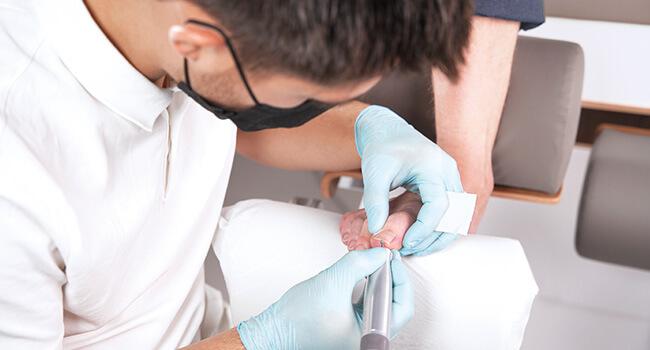
Why do podiatry treatments in particular, pose an ergonomic challenge?
Your profession takes up a large part of your everyday life. This inevitably means that your body is subjected to all the work processes you go through in your practice - day after day, month after month, year after year. Sitting for long periods of time and leaning forward, often twisted, towards the work equipment is not considered to be particularly back-friendly! The amount of time spent in these postures has an enormous impact on your physical health and can ultimately determine how long you stay fit and free of health problems. So putting the focus on creating a low-strain workplace is nothing more than a logical conclusion. After all, nothing is more valuable than your health and the preservation of it.
However, we do not leave you alone with this task - the ability to work ergonomically is primarily provided by the products that you use every day. Be it the stool you sit on or the instrument you reach for: We at RUCK do our best to support you and your body.

Positioning your equipment correctly - what does it depend on?
From an ergonomic point of view, in order to avoid tension and relieve the back, the reach zones to the moveable podiatry cabinet with its organisation systems, the placement of the instrument tray and the magnifying lamp all play important roles, as well as the height-adjustable practitioner chair and the adjustable treatment chair.
The principle that Hellmut Ruck puts to the heart of all participants in each of his workshops is as follows: “It is not the practitioner who comes to the foot, but the foot who comes to the practitioner.” For this to succeed, you need a treatment chair that fulfils its purpose as the central working unit and offers a high degree of versatility. The ability to
lift, lower, rotate and tilt your patient and adjust the footrests individually, in order to bring the foot to your desired position, is of great importance for ergonomic working and makes a huge difference to your comfort levels. However, you should alternate your treatment position from time to time. All our treatment chairs can also be used for treatment in a standing position, using their height adjustment function. Working at eye level not only offers the added benefit of working more precisely, but also brings noticeable relaxation to the joints and muscles in the back and legs. Using the included foot control, the positions of the patient can be continuously changed according to the specific anatomy of the patient and your personalised requirements, without having to reach or twist.

The three ergonomic reach zones
According to the “Ergonomics Data Base” of the German Institute for Occupational Safety and Health, every workplace should be optimally set up by observing defined specifications for lighting, room temperature and movement zones. In podiatry, this results in the identification of three ergonomic reach zones, which characterise the space within which you can reach all work areas and materials easily and without constant twisting of your body. A moveable podiatry cabinet on smooth-running castors has considerable additional benefits here: It offers storage space for instruments, an integrated podiatry drill, a swivelling magnifying lamp and adequate storage space for consumables. Its ability to be moved easily means that it can always be placed in the optimal position and can be “pulled up” or “pushed away” as required, during treatment.
The first zone:
Direct access
The first zone describes the direct access, i.e. the area that is located directly in front of you, approximately at the level of your navel. Ideally, the sitting position is upright and allows you to work close to your body with relaxed shoulders.
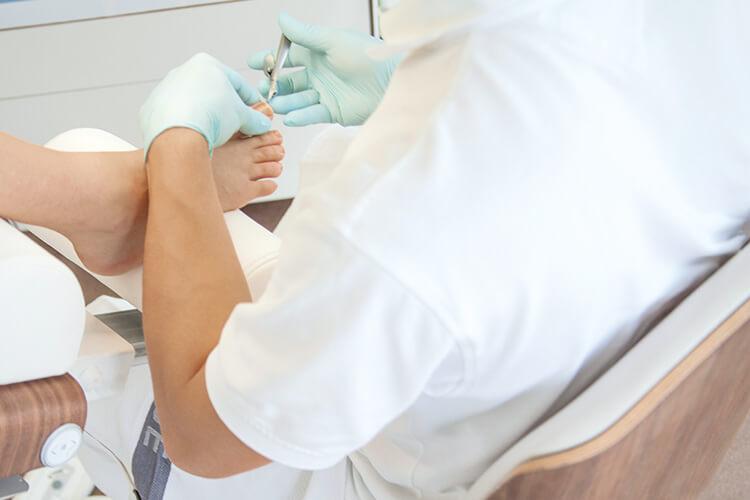
The second zone:
Extended work centre
The second zone is the extended work centre and encompasses everything that you can easily reach without having to strain. All instruments and work materials that are used frequently are should be placed in this zone. You should be able to reach all items easily without extending your arms.
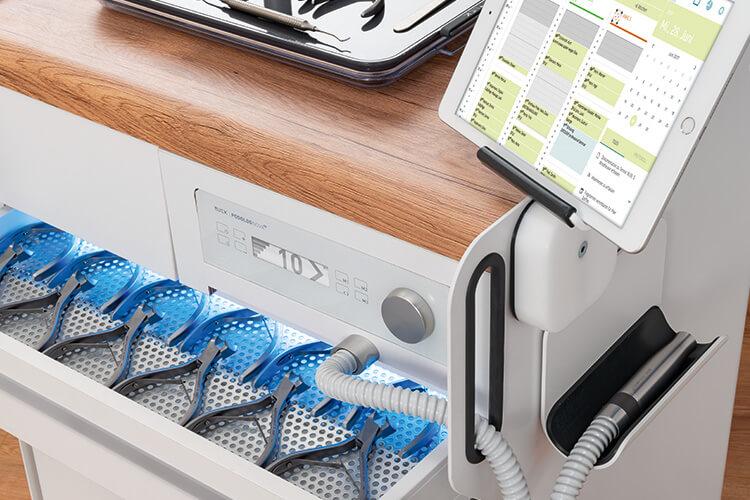
The third zone:
The one-handed zone
The third zone is accessible to you with an extended arm and can be reached and operated with one hand. Typically, skincare products or products that are not frequently used are placed here.
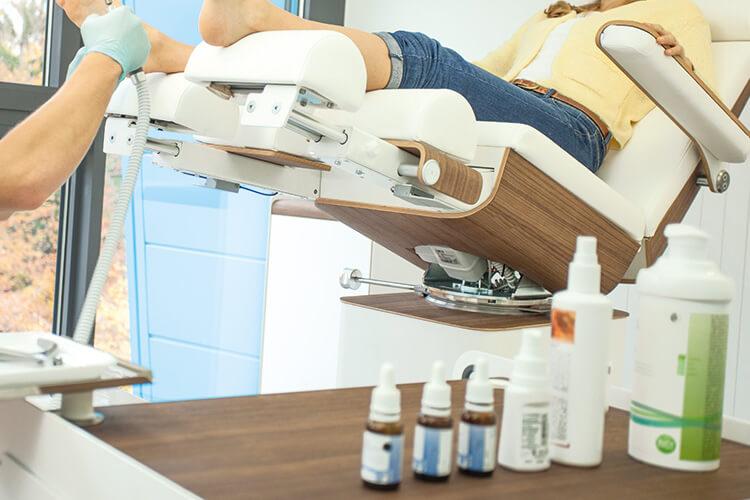
Intelligent fitting: How and where to mount accessories to ensure they are ergonomically correct
The back-friendly alignment of your practice equipment is not the end of the story. On the contrary, it is often the little things that can ultimately determine whether you can really work in an ergonomically correct manner. Your many tools and accessories for everyday treatment therefore need to be placed around you in a sensible way. This way you don’t have to twist to reach everything and avoid tension. In order to correctly attach magnifying lamps, your podiatry drill and your instrument tray to your work cabinet according to ergonomic principles, we have considered the three reach zones in advance and would like to give you some help and tips below. Please note that you should reverse the recommendations if you are left-handed.
The magnifying lamp
To ensure that the working area is optimally illuminated, we recommend that you mount the magnifying lamp diagonally to your podiatry drill. As a right-handed person, this means mounting the lamp at the back on the left-hand side of your work cabinet so that it can be reached from above and pulled towards the work area. If you mount the lamp on the right-hand side, it will have to reach across the entire work surface of the cabinet, which would cost you too much of the lamp’s reach. Another benefit of this recommended placement is that it makes the lamp appear to come out of the space, which contributes to more harmonious lighting and thus a comfortable room ambience. If it were mounted at the back on the right, it would cross the treatment room in an untidy manner. In order to make your personal reach zone as flexible as easy as possible, depending on the treatment situation you are in, the head of your magnifying lamp should be ready for repositioning from the first to the third reach zone.
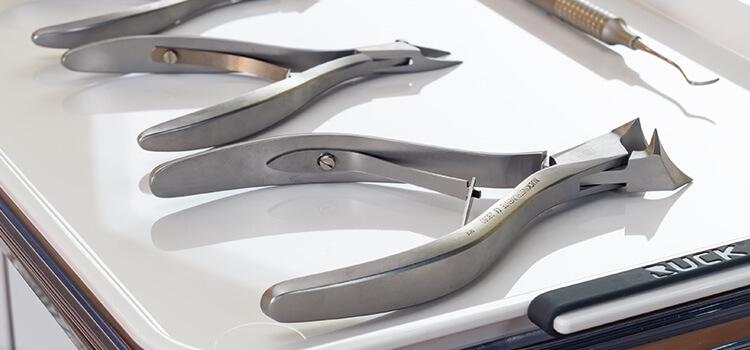
The instrument tray
In order to access all required tools within this reach zone and to take full advantage of ergonomic workstation design, be sure to position everything with you in mind, whether you are right- or left-handed. For example, place the magnifying lamp on the left so that the instrument tray is on the right front and thus as close to your body as possible.
The podiatry drill
Integrating the podiatry drill on the right side of the podiatry cabinet makes practical sense because frequent operation is facilitated by the proximity to you as the practitioner and you can make optimal use of the lengths of the suction hose. The second reach zone used here affects your ability to reach the podiatry drill easily. It is also recommended to mount the handpiece tray and the waste container on the right to ensure proximity to you and to the podiatry drill.
There is no such thing as the perfect working position. Remember: the best position is always the next one! What our body needs is variety.
Staying moveable while seated
The optimum working posture is influenced positively by practice equipment that is configured in an ergonomically practical way and contributes a great deal to maintaining physical health. However, there is no such thing as the perfect practitioner position, because the best one is always the next one. A rigid sitting position puts permanent strain on the spine. This reduces the blood supply to the intervertebral discs and the back muscles have to do a lot of hard work. This quickly leads to excessive strain, which can cause headaches and back pain, tension and a drop in performance. The resultant damage is often a painful slipped disc.
You should avoid a rigid and the same continuous seated position and instead, adopt a more dynamic approach by moving in all directions. Your muscles are activated by the body dynamics, blood circulation is stimulated and metabolism is increased. More motion can easily be integrated into your daily work life: For example, make a resolution that you should do one treatment a day while standing. As soon as you notice how good the change does you, the dynamic work will come naturally - we can guarantee that!
The right choice of instrument: Why ergonomic working is also located in your hands
As a podiatrist, you work on patients’ feet for up to ten hours a day. That’s approximately 1,800 hours a year. The most important “tools” are your hands. The concentrated work on the feet requires a lot of strength and endurance, which also strains the muscles of the arms, shoulders and neck. Hunched postures and strenuous manual work take their toll: tension, hand, arm and back pain are common. In the long term, there is a risk of permanent damage such as the dreaded carpal tunnel syndrome and other repetitive strain injuries. But this can be counteracted by conscious and ergonomic working with the hands.
Our hands are an anatomical masterpiece. Gripping powerfully or threading the finest yarn - everything is easy for them. The hand is made up of 27 individual bones, over 30 muscles and tendons, nerves and blood vessels. Their delicate construction with thin bones and little protective muscle and fatty tissue makes hands easily vulnerable. The high daily strain often leads to wear-related health problems. No wonder, because in the course of our lives our fingers are bent and stretched about 25 million times.





















































